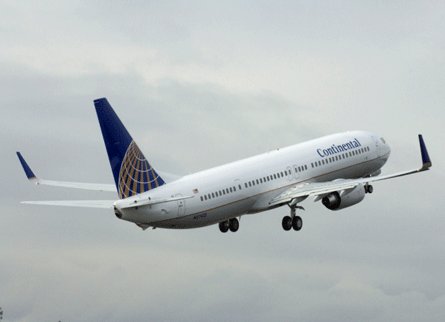Squeezed by their major partners and by rising costs, US regional airlines have tried investing in new ventures at home and abroad with mixed results, but are determined to continue diversifying
Just a year ago, the regional carriers of the USA faced a problem they'd dearly like to have today: they just could not hire qualified pilots quickly enough to support their growth. Expansion at the big airlines was exacerbating the problem as the majors lured away the most experienced regional pilots. Now, though, as the large airlines shrink and consolidate, cutting costs wherever they can, including the costs of regional flying, the situation is diametrically changed.
"A year ago, you and I would have been discussing attrition rates now, job security is uppermost on everyone's minds," says Bryan Bedford, chairman of Indianapolis-based Republic Airways Holdings and this year's chairman of the Regional Airline Association. As Roger Cohen, the RAA's president and full-time Washington head says: "What a difference a year makes."
 |
|---|
"Look at the crisis in banking, where the credit markets are not functioning. It's harder to get financing"Bryan Bedford |
Take, for example, Pinnacle Airlines, the Memphis-based owner of two carriers, Pinnacle and Colgan. Until three years ago, it was a simple operation, flying 50-seat regional jets and a few Saab turboprops for Northwest Airlines and Northwest alone. But as the majors began to squeeze the regionals, it looked to diversify. Pinnacle sought new contracts and won a deal flying for Delta Air Lines. Then it went a step further and acquired a small "mom-and-pop" operator called Colgan Air, based in Manassas, Northern Virginia. Colgan had been founded by a Virginia state senator and had long been a small turboprop operator. Pinnacle president Phil Trenary says: "We were attracted as much by its culture as anything else. We saw it as a small family company that would mesh with us. And we liked their turboprop expertise. I wish I could tell you that I was smart enough to have foreseen the fuel crisis and the growing value of turboprops, but it was the business itself that attracted us."
The company bought Bombardier Q400s and assigned them to Colgan's Continental Express operation at Newark, where they are providing customers with a surprise: they're roomier and quieter than the 50-seat regional jets that make up Pinnacle's main fleet.
CHANGING COLGAN
At Colgan, Pinnacle has devoted considerable management time and effort to making a small carrier into a "big little carrier", says Phil Reed, the Pinnacle executive vice-president who spends much of his time in Manassas co-ordinating the efforts. George Casey, the long-time president of Colgan, says: "We're keeping our culture as a family but we have to grow into a company where we do things by a routine, by a process, instead of just knowing that someone else has down what he's supposed to do." To that end, Colgan hired a maintenance specialist away from Republic and a US FAA compliance specialist away from Continental Air Micronesia and beefed up elsewhere.
At Pinnacle itself, a new contract with Delta provided a second major source of revenue - until this spring. That is when Delta surprised the industry by announcing it was cancelling contracts with Pinnacle and with another regional company, Mesa. Delta claimed that the regionals had failed to deliver on-time service, which each disputed. Pinnacle, says Reed, "resolved the problem the way we approach things: we sat down and talked with Delta". Trenary notes that the Delta pact, which now runs until 2017, involves flying the Bombardier CRJ900, which he calls "the 50-seater done right", adding that "the most important thing for us is to grow the -900 fleet".
Pinnacle's plans are relatively traditional when compared with some of the industry's more creative efforts. ExpressJet, for instance, tried independent branded flying, using Embraer regional jets made surplus when Continental cut its flying in late-2005. The airline, once a Continental subsidiary but spun-off in 2002, carefully identified cities across the US that had a need for point-to-point service. ExpressJet made a good try at marketing itself, installing satellite radio onboard, offering some creative fares and scheduling so that day trips were convenient. The experiment failed utterly, and after just 19 months the company withdrew all of its aircraft dedicated to flying scheduled routes under its own name as of 2 September.
ExpressJet Holdings chief executive Jim Ream says: "While we're pretty darn happy with the revenue performance looking at our first anniversary going into this summer, a lot of the progress we've made on the revenue side was just being consumed with an ever-increasing fuel price." Other attempts by ExpressJet to diversify away from reliance on a single contract also ran into difficulties: it operated briefly for Delta out of the Salt Lake City and Los Angeles hubs, but Delta withdrew that flying in September after 15 months. Except for charter flying it began when it diversified, ExpressJet is now a smaller airline, flying 205 aircraft out of its 274-aircraft fleet as Continental Express under a new "much more challenging" contract, as Ream puts it.
TAKEOVER TARGET
ExpressJet's troubles imply that the original model is the only one that works, but the airline did briefly become a takeover target for another airline looking to diversify. In April, SkyWest, the holding company for the largest regional family, made an unsolicited offer - at $3.50 a share, a steep premium to the price of the now-untraded ExpressJet shares. The company rejected the offer, and SkyWest withdrew after Continental signed its new deal with ExpressJet in June.
 |
|---|
But SkyWest chairman Jerry Atkin had continued looking for opportunities to invest in regionals elsewhere, and in early September he signed a deal in Brazil to invest $5 million in regional carrier TRIP for a 6% stake, under an agreement that would allow the stake to grow to 20% in the next two years if the Brazilian regional meets certain performance conditions. SkyWest vice-president of finance and treasurer Michael Kraupp says that the parent company will be more than a passive investor and would lend its expertise to TRIP as the Brazilian carrier, which is transitioning to Embraer jets from a mixed turboprop fleet, inks codesharing deals with larger airlines there. Brazil and other rapidly growing countries are indeed attractive. Doug Abbey, the Seabury Group consultant to regionals, says: "Right now everybody's looking at the BRIC countries, Brazil, Russia, India, China. The US domestic market is a no-growth market and operators of 50-seaters know it."
Chip Childs, the president and chief operating officer of SkyWest Airlines, says the SkyWest model of multiple codeshares is one that could easily be replicated elsewhere, and that the company is actively looking for more opportunities. "We'd be foolish if we weren't looking everywhere we can," he says. SkyWest also faced operating pressure from Delta, but that was at the parent's ASA unit, a former Delta subsidiary.
Childs says SkyWest is expanding into routes throughout the Pacific Northwest that have been abandoned as Horizon, Alaska Air Group's regional, pulls out. Horizon is dumping its 37-seat regional jets and going to an all-Q400 fleet, and these 74-seaters are too big for some routes. "For many of those routes, the 50-seat jet is just ideal" and so are SkyWest's 30-seat Embraer turboprops, Childs says. But he adds that his major goal right now is finding homes for the nine SkyWest 50-seat CRJs that are to be pushed out of service from Midwest Airlines.
SkyWest continues to operate 12 aircraft for Midwest as Midwest Connect.
Privately-held Midwest, which is trying hard to avoid bankruptcy, earlier shifted flying to SkyWest, but as its losses continued, the Milwaukee-based carrier signed a deal in September with Republic Airways Holdings. Republic will fly a dozen of its 76-seat Embraer E-170s for Midwest under a deal that will let Midwest return all but 12 of its 25 Boeing 717s to Boeing. But importantly, this is not just an aircraft deal: Republic will lend Midwest $15 million, and commit to another $10 million if Midwest meets certain performance criteria.
The deal, which brings a total of $60 million to Midwest, is similar to an investment in September in which Republic was a major lender in a $30 million package for Frontier Airlines. Both Midwest and Frontier owe Republic money. But Bedford says Republic offered better terms than Denver-based Frontier would have had under a private equity loan it had tentatively agreed. He explains: "When we saw the kinds of deals that Frontier was making for debtor-in-possession financing, we saw that it simply could get a better deal [from us]. Look at the crisis in banking, where the credit markets just are not functioning. It's just harder to get financing for deals."
OVERSEAS FINANCING
Indeed, financing for regional jet deals has moved largely abroad, Bedford says. The company has begun moving out ERJ-135s on an expedited schedule after Delta asked it to, and the last 11 of the 36-seaters were due out by the end of September. "We have been able to sell the -135 and above our book values, not significantly above, but we haven't lost any money on those deals. But look at what Continental is doing grounding the -135s and American is grounding the -135s, and we are certainly paying attention to whether or not there is an adverse impact to the carrying values for small jets."
Embraer, much like Bombardier, having developed expertise in overseas deals, is likely to be lending its expertise to US regionals looking at overseas deals, says John Luth, chairman of the Seabury Group consultancy. "We could very well see the airframers leading the way on international deals that package their expertise with that of the operators," Luth says.
At Mesa Air Group, the attempts at overseas diversification have not worked out as well. The Phoenix-based company's chief executive, Jonathan Ornstein, says: "We were ahead of the curve in trying to find homes for the 50-seaters. Unfortunately it didn't quite work out. In China, it's just proven more difficult than we thought. We looked at the growth rates and so on and we thought building a hub at Shenzhen would work." Mesa in December 2006 signed a deal to set up a regional operation with 50-seater CRJs in mainland China in a joint venture with locally-based Shenzhen Airlines, a venture dubbed Kunpeng.
 |
|---|
"It's just a matter of time and waiting for oil to come down. I've seen so many bubbles in my time"Jonathan Ornstein |
But that seven-aircraft Hawaiian venture, while losing money on fuel, also drew Ornstein and Mesa into a legal morass in which a judge held that a Mesa corporate officer had misused trade secrets. And Mesa had to shut its 19-seat turboprop operation, Air Midwest, in April and then ran into problems with one of its major codeshare partners, Delta. Delta, charging that Mesa, much like Pinnacle, had failed to live up to the terms of a codesharing pact on ERJ-145 flying, said it was ending the deal. Mesa sued and won an injunction in June, but Ornstein says: "We weren't crying wolf when we said we'd have to file if we lost the Delta flying."
To make matters worse, in August Delta moved to cancel another contract, this one for flying that Mesa does with larger CRJ900s at New York's JFK airport. This contract is worth about $25 million a year in revenue to Mesa, while the contract that Delta moved to annul in May produced about $200 million in annual revenues. Holly Hegeman of planebusiness.com says: "Delta is putting the screws to all of its regional providers. Clearly management at Delta is doing what management at Delta should have done when it was in bankruptcy protection. They are trying to weed out some of the airline's regional feed."
Ornstein says Mesa has major bond debt due in January and February, and "clearly the company does not have the money to pay the bonds, so we'll have to be creative". He adds: "We'll work our way out. In two years, oil could be back down to $80 a barrel. Look at a year or two ago, when we were having trouble getting enough pilots and so on. Now, we have people who left here and went to Continental or another major and now they want to come back. It's just a matter of time and waiting for oil to come down. I've seen so many bubbles in my time."
But the regional industry, says Seabury's Abbey, knows that the days of reliance on a singe contract are ending and it knows that the 50-seat model must change. Bedford acknowledges this, saying: "I've never said that there's no 50-seat market, but it may be oversupplied by as much as 300 planes. We can do with 1,000, not 1,300 aircraft. The major partners are certainly looking at getting every bit of value out of their contracts and they're right, a bargain is a bargain. What we have to do is provide the best product we can at the lowest cost. In the end, the lowest-cost quality provider will be the survivor."
To find out more about how US regionals began their strategy of branching out read: flightglobal.com/usregionals
Source: Airline Business























